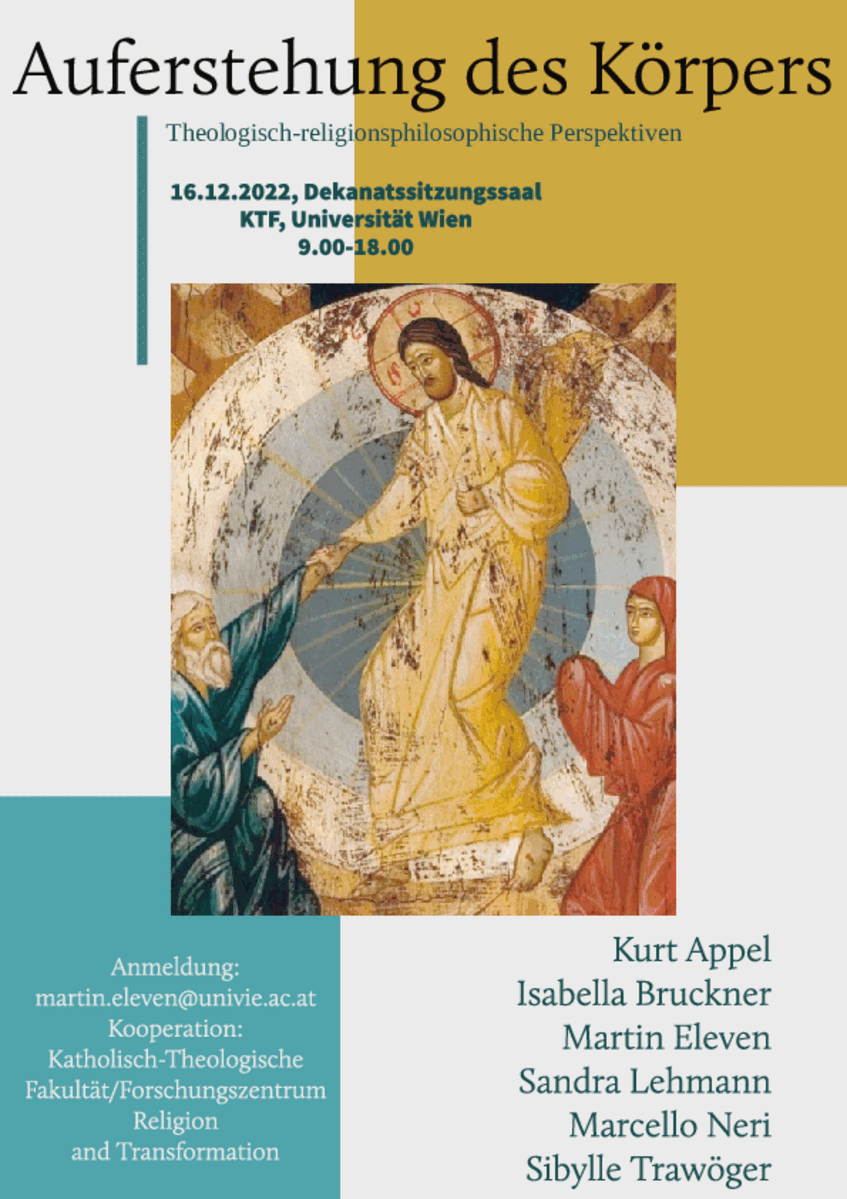Conference: Resurrection of the Body

Conference: Resurrection of the Body
When: December 16, 2022
Where: Dekanatssaal, Faculty of Catholic Theology, University of Vienna, Main Buildung
Conference Report: On 16.12.2022 the Department of Fundamental Theological Research (organization: Martin Eleven) in cooperation with the Research Center RaT organized a workshop on the topic "Resurrection of the Body - Theological-Religious-Philosophical Perspectives". The background of the event was the question of the genuine place of the body in contemporary theology: Is there not a certain body oblivion? Which concepts of the body, if it becomes a topic in its own right, are primarily used to interpret the Christian message of the resurrection? What can be said about the body of the resurrection?
The contributions of the speakers have tried from different angles - philosophical, aesthetic and political - to give answers to the question of the body of resurrection and to rethink traditional concepts and terms. After a general welcome and introduction of the workshop by Martin Eleven, who tried to illuminate theology in its ambivalent relationship to the body, Sibylle Trawöger devoted her lecture to the relationship between resurrection and decay. Both from a microbiological point of view and with the help of aesthetic considerations, she pleaded for the consideration of life processes of the body, which include the corpse. This perspective, Trawöger argued, allows one to subvert anthropocentric notions of what life after death might mean. Examples from art and literature served her as a guide to practicing this new view.
The following lecture was given by Sandra Lehmann on the Pauline distinction between sōma psychikon (earthly body) and sōma pneumatikon (redeemed body). Her focus was not only on the salvation-historical dimension of the sōma pneumatikon, but also, drawing on the tradition of the Stoa and the contemporary Philosophy of Mind, on the inner transcendence of the body, which has always pointed it beyond itself. Martin Eleven addressed the politics of the body. Starting from structuralist-phenomenological considerations, he devoted himself to the cinematographic realizations of corporeality in Pasolini's films. He interpreted the bodies and their gestures shown in Pasolini's films - with reference to the Emmaus narrative - as the afterlife of a historical horizon and its open and not yet redeemed potential, as well as a call to discipleship that takes human vulnerability seriously.
Marcello Neri gave a lecture on the naked body of Christ, which in its woundedness and vulnerability becomes a symbol of a God broken in himself. Starting from the Ascension of Christ, he asked how the return of the risen Son (with his wounds) to the Father can be understood and what consequences this event has for our conceptions of God. Isabella Bruckner then spoke about the role of the body in the baptismal rite, pointing out that baptism already signifies entry into the resurrection remnant. In addition, the concrete corporeality in liturgical practice was illuminated.
Finally, Kurt Appel devoted his lecture to the relationship between text and body. The starting point was the resurrection narrative of the Gospel of Mark. He emphasized that a closer reading shows how the body (of Christ), which in the narrative is only thematized as withdrawn, becomes a text, namely where the Gospel invites to discipleship and thus the resurrected body becomes a retreat for the faithful. These considerations were enriched with speculative thoughts from Hegel's science of logic.
